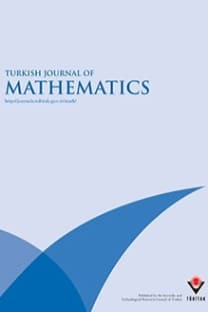Repdigits as sums of two generalized Lucas numbers
Repdigits as sums of two generalized Lucas numbers
___
- [1] Bravo JJ, Gómez CA, Luca F. Powers of two as sums of two k -Fibonacci numbers. Miskolc Mathematical Notes 2016; 17: 85-100.
- [2] Bravo JJ, Luca F. On a conjecture about repdigits in k -generalized Fibonacci sequences. Publicationes Mathematicae Debrecen 2013; 82 (3-4): 623-639.
- [3] Bravo JJ, Luca F. Repdigits in k -Lucas sequences, Indian Academy of Sciences. Proceedings Mathematical Sciences 2014; 124 (2): 141-154.
- [4] Bravo JJ, Luca F. Repdigits as sums of two k -Fibonacci numbers. Monatshefte für Mathematik 2015: 176: 31-51.
- [5] Bugeaud Y, Maurice M, Siksek S. Classical and modular approaches to exponential Diophantine equations I. Fibonacci and Lucas perfect powers. Annals of Mathematics 2006; 163 (3): 969-1018.
- [6] Dujella A, Pethö A. A generalization of a theorem of Baker and Davenport. The Quarterly Journal of Mathematics 1998; 49 (2): 291-306.
- [7] Faye B, Luca F. Pell and Pell-Lucas numbers with only one distinct digit. Annales Mathematicae et Informaticae 2015; 45: 55-60.
- [8] Irmak N, Togbé A. On repdigits as product of consecutive Lucas numbers. Notes on Number Theory and Discrete Mathematics 2018; 24 (3): 95-102.
- [9] Luca F. Fibonacci and Lucas numbers with only one distinct digit. Portugaliae Mathematica 2000; 57 (2): 243-254.
- [10] Marques D, Togbé A. On repdigits as product of consecutive Fibonacci numbers. Rendiconti dell’Istituto di Matematica dell’Universitá di Trieste University Studi Trieste 2012; 44: 393-397.
- [11] Matveev EM. An explicit lower bound for a homogeneous rational linear form in logarithms of algebraic numbers II. Izvestiya Rossiiskoi Akademii Nauk. Seriya Matematicheskaya 2000; 64: 125-180. English translation in Izvestiya Mathematics 2000; 64: 1217-1269.
- [12] Miles EPJr. Generalized Fibonacci numbers and associated matrices. American Mathematical Monthly 1960; 67: 745-752.
- [13] Miller MD. Mathematical notes: on generalized Fibonacci numbers. American Mathematical Monthly 1971; 78: 1108-1109.
- [14] Rayaguru SG, Panda GK. Repdigits as product of consecutive balancing and Lucas-balancing numbers. The Fibonacci Quarterly 2018; 56 (4): 319-324.
- [15] Rayaguru SG, Panda GK. Repdigits as product of balancing and Lucas-balancing numbers with indices in arithmetic progressions. The Fibonacci Quarterly 2019; 57 (3): 231-237.
- [16] Sanna C. The p-adic valuation of Lucas sequences. The Fibonacci Quarterly 2016; 54 (2): 118-124.
- [17] Şiar Z., Keskin R., Repdigits as sums of two Lucas numbers, Applied Mathematics E-notes, 20 (2020); 33-38.
- [18] Waldshmidt M. Diophantine Approximation on Linear Algebraic Groups: Transcendence Properties of the Exponential Function in Several Variables. Berlin, Germany: Springer-Verlag Berlin Heidel-berg, 2000.
- [19] Wolfram DA. Solving generalized Fibonacci recurrences. The Fibonacci Quarterly 1998; 36 (2): 129-145.
- ISSN: 1300-0098
- Yayın Aralığı: 6
- Yayıncı: TÜBİTAK
A class of operators related to m-symmetric operators
Extensions of the matrix-valued q−Sturm–Liouville operators
Bilender PAŞAOĞLU ALLAHVERDİEV, Hüseyin TUNA
Banach algebra structure on strongly simple extensions
Hadjer BELBALI, Maamar BENBACHIR
General rotational ξ−surfaces in Euclidean spaces
Kadri ARSLAN, Betül BULCA, Yılmaz AYDIN
A short note on generic initial ideals
Repdigits as sums of two generalized Lucas numbers
Jhon Jairo BRAVO, Sai Gopal RAYAGURU
Integer-valued polynomials satisfying the Lucas property
Rattiya MEESA, Tuangrat CHAICHANA, Vichian LAOHAKOSOL
Muhammet KAMALI, Mirzaolim TURABAEV, Erhan DENİZ, Murat ÇAĞLAR
